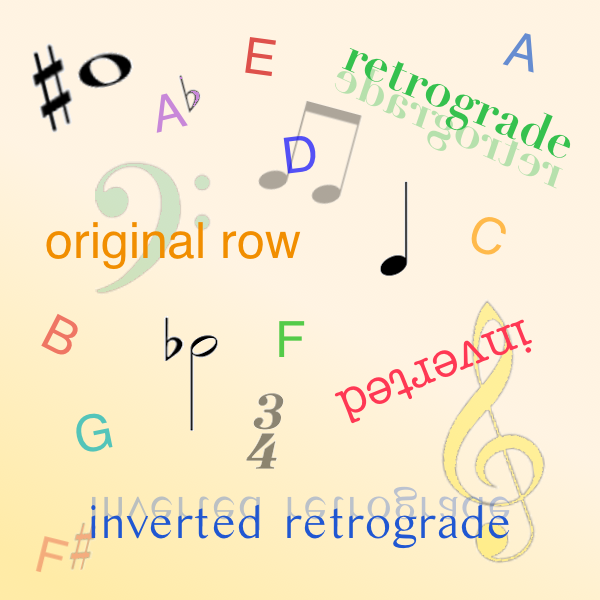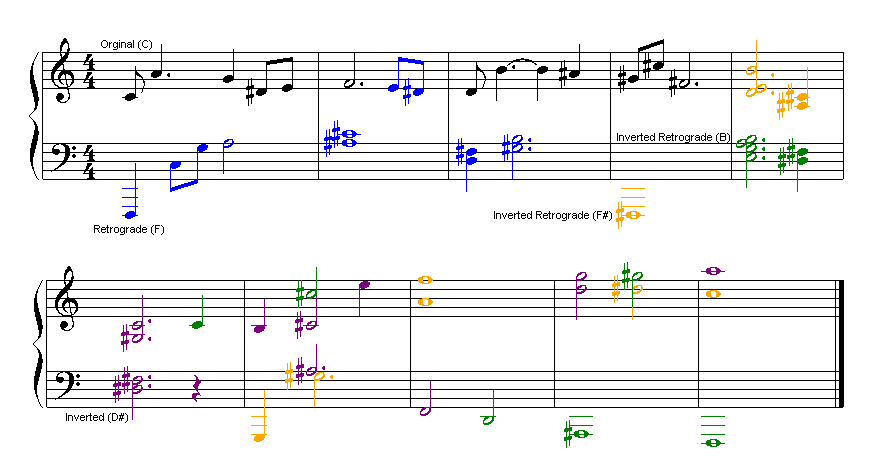How to Write a 12-Tone Composition

Twelve-tone is a 20th-century compositional technique created by Arnold Schoenberg.
Rather than setting a piece of music in a diatonic key, the goal of 12-tone music is to use all 12 chromatic pitches equally.
To create a 12-tone composition, follow these steps:
Create Your Palette
-
Begin with a 12x12 grid. Label your grid as in the example below:

- Next, arrange the 12 chromatic pitches in any order you like.
This is your 12-tone row, which will form the basis of your composition.
Fill in the first row of the grid with your 12-tone row.
Check to make sure that you have used each note exactly once.
Example:
 I find it easiest to write down both spellings of the chromatic pitches. This helps both in calculating the intervals
and in proofreading your work.
I find it easiest to write down both spellings of the chromatic pitches. This helps both in calculating the intervals
and in proofreading your work.
- Next, calculate the inversion of your row.
Do this by finding the inversion of each interval, and write the inverted
row down the left column of your grid.
Looking at the above example, the first interval is C to A. A is a minor third down from C.
The inversion of this would be a minor third up from C, which is E-flat.
The next interval in my original row is A to G.
G is a major second down from A, so in the inversion, you would calculate a major second up from E-flat, which is F.
G to E-Flat is a descending major third. An ascending major third from F is A.
The resulting inverted row is as follows:
 Double-check your inverted row to make sure you have used each note exactly once.
Double-check your inverted row to make sure you have used each note exactly once.
- Fill in your grid by transposing your 12-tone row into each key listed down the left column of the grid.
Example:
 This is your palette. Reading from left to right, you have your original row in all 12 keys.
Reading from top to bottom, you have the inversion of your row.
Reading from right to left gives you the retrograde of your row, and reading from bottom to top gives you
the inverted retrograde.
This is your palette. Reading from left to right, you have your original row in all 12 keys.
Reading from top to bottom, you have the inversion of your row.
Reading from right to left gives you the retrograde of your row, and reading from bottom to top gives you
the inverted retrograde.
Again, you can spot-check your work by making sure any given row contains exactly 12 distinct pitches.
Write Your Composition
Using the palette that you have created, write your composition.
The following rules apply:
- Select any row in your palette: original, inverted, retrograde, or inverted retrograde, starting on any pitch.
- Once you begin a row, you must follow it to completion:
you must play all the pitches in order, you may not skip any pitches, and you may not repeat any pitches.
- Notes may occur in any octave any may last any duration.
You may begin two or more notes simultaneously, as long as they occur sequentially in the row.
- Any number of rows may be played concurrently. They may begin and end at any time;
rows do not have to start or end together. Any types of row may be played concurrently,
starting on any pitch.
Example
The following is a simple example of a composition based on the above palette.

Comments
Thanks for the explanation! The example really helps. Yet I wonder if you may have mixed up the labels of the palette? Inverted mixed up with original, and retrograde with inverted retrograde? Or maybe I misunderstand something?Posted by Amy on Saturday, July 9, 2022Shouldn't it say original row along the top and inverted on the side, instead of the way it is now?Posted by mjazz on Sunday, July 25, 2021This was really helpful and was very useful for my school work. Thank you for thisPosted by Leo G on Tuesday, May 19, 2020Hi Avídia,
If you have a repeated pitch in your inversion, first make sure that you don't have a repeated pitch in your original row. If your original row is correct, a repeated pitch in the inversion means that you made a mistake somewhere in calculating the inverted interval.
If you like, send me a private comment (leave a comment and check the "Private" checkbox) containing your email address, your original row and the inversion you're having trouble with. I will take a look at it, help you find the problem, and email you back.Posted by Carolyn on Sunday, April 19, 2020I don't understand this technique. Whatever order I pick, when I calculate the inversions, a pitch will always repeat itself.Posted by Avídia on Saturday, April 18, 2020
Good philosophy must exist, if for no other reason, because bad philosophy needs to be answered.— C.S. Lewis
The Weight of Glory and Other Addresses

Twelve-tone is a 20th-century compositional technique created by Arnold Schoenberg. Rather than setting a piece of music in a diatonic key, the goal of 12-tone music is to use all 12 chromatic pitches equally. To create a 12-tone composition, follow these steps:
Create Your Palette
-
Begin with a 12x12 grid. Label your grid as in the example below:

- Next, arrange the 12 chromatic pitches in any order you like.
This is your 12-tone row, which will form the basis of your composition.
Fill in the first row of the grid with your 12-tone row.
Check to make sure that you have used each note exactly once.
Example:I find it easiest to write down both spellings of the chromatic pitches. This helps both in calculating the intervals and in proofreading your work.
- Next, calculate the inversion of your row.
Do this by finding the inversion of each interval, and write the inverted
row down the left column of your grid.
Looking at the above example, the first interval is C to A. A is a minor third down from C. The inversion of this would be a minor third up from C, which is E-flat.
The next interval in my original row is A to G. G is a major second down from A, so in the inversion, you would calculate a major second up from E-flat, which is F.
G to E-Flat is a descending major third. An ascending major third from F is A.
The resulting inverted row is as follows:Double-check your inverted row to make sure you have used each note exactly once.
- Fill in your grid by transposing your 12-tone row into each key listed down the left column of the grid.
Example:This is your palette. Reading from left to right, you have your original row in all 12 keys. Reading from top to bottom, you have the inversion of your row. Reading from right to left gives you the retrograde of your row, and reading from bottom to top gives you the inverted retrograde.
Again, you can spot-check your work by making sure any given row contains exactly 12 distinct pitches.
Write Your Composition
Using the palette that you have created, write your composition. The following rules apply:
- Select any row in your palette: original, inverted, retrograde, or inverted retrograde, starting on any pitch.
- Once you begin a row, you must follow it to completion: you must play all the pitches in order, you may not skip any pitches, and you may not repeat any pitches.
- Notes may occur in any octave any may last any duration. You may begin two or more notes simultaneously, as long as they occur sequentially in the row.
- Any number of rows may be played concurrently. They may begin and end at any time; rows do not have to start or end together. Any types of row may be played concurrently, starting on any pitch.
Example
The following is a simple example of a composition based on the above palette.

Comments
Thanks for the explanation! The example really helps. Yet I wonder if you may have mixed up the labels of the palette? Inverted mixed up with original, and retrograde with inverted retrograde? Or maybe I misunderstand something?
Posted by Amy on Saturday, July 9, 2022
Shouldn't it say original row along the top and inverted on the side, instead of the way it is now?
Posted by mjazz on Sunday, July 25, 2021
This was really helpful and was very useful for my school work. Thank you for this
Posted by Leo G on Tuesday, May 19, 2020
Hi Avídia,
If you have a repeated pitch in your inversion, first make sure that you don't have a repeated pitch in your original row. If your original row is correct, a repeated pitch in the inversion means that you made a mistake somewhere in calculating the inverted interval.
If you like, send me a private comment (leave a comment and check the "Private" checkbox) containing your email address, your original row and the inversion you're having trouble with. I will take a look at it, help you find the problem, and email you back.
If you have a repeated pitch in your inversion, first make sure that you don't have a repeated pitch in your original row. If your original row is correct, a repeated pitch in the inversion means that you made a mistake somewhere in calculating the inverted interval.
If you like, send me a private comment (leave a comment and check the "Private" checkbox) containing your email address, your original row and the inversion you're having trouble with. I will take a look at it, help you find the problem, and email you back.
Posted by Carolyn on Sunday, April 19, 2020
I don't understand this technique. Whatever order I pick, when I calculate the inversions, a pitch will always repeat itself.
Posted by Avídia on Saturday, April 18, 2020
Good philosophy must exist, if for no other reason, because bad philosophy needs to be answered.
— C.S. Lewis
The Weight of Glory and Other Addresses
The Weight of Glory and Other Addresses



